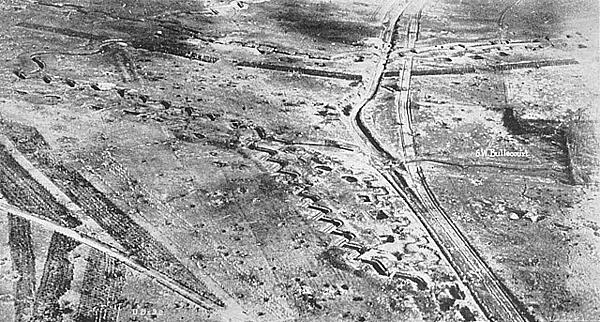First Bullecourt
On 12th April 1917, the German lines at Bullecourt were attacked by the Australians - the first time anyone had attempted to substitute an artillery bombardment with tanks.
During the previous months, the Germans had withdrawn their men to what we now call the Hindenburg Line (an area they knew well and had strong defences already in place) in preparation for the Allied spring offensive they believed would occur at the start of 1917.
As the Germans withdrew, British troops advanced into the old German lines and made plans to attack the enemy on 9th April. However, they wanted a subsidiary attack to take place in the northwest of the Hindenburg Line in Bullecourt; British commanders believed that a break through in Arras would force the Germans to retreat to Bullecourt and cause them to become trapped. As such, the attack on Bullecourt was planned for 19th April.
Despite being an unremarkable village, Bullecourt was home to parts of the Hindenburg Line in its east, west and south. As a result, the 62nd (West Riding) Division was ordered to attack the west, while the 4th Australian Division (part of the 1 Anzac Corps) was ordered to attack the east. Both of these attacks would take place with the aid of tanks.
However, just days before the attacks were due to begin, senior officers within the 4th Australian Division started to express their doubts, stating that they thought German fire from Quéant (the next town) would result in significant casualties among the Allied troops. Officers including Major-General White suggested that the towns should be attacked simultaneously.
The promise of artillery attack reassured many but reconnaissance showed that the artillery fire had failed to have the desired impact on the enemy. As such, the attack was delayed by two days.

On 9th April, the 1st and 3rd Armies attacked the Germans at Arras and Vimy, with the initial attacks proving successful. On the back of this triumph, Sir Hubert Gough, commander of the 5th Army, decided to move forward the date for the Bullecourt back to the 10th April, as had been the initial plan.
Gough based his decisions on a plan developed by Major Watson of the Royal Tank Corps. Watson believed that a large number of tanks (12 RTC tanks) could move to the German positions at Bullecourt with infantry from the 4th Australian Division following, and stating that the confusion of battle would prevent them from being attacked by artillery. Once the tanks breached the Hindenburg Line, the troops would move into the village and take it out while the 62nd Division attacked from the West. The Australians would then move on to their next target - Riencourt.
While Gough supported this idea, the Australian commanders did not feel so positive. Their two main concerns were that they did not have time to plan the attack and that the tanks were likely to be noticed by the Germans as they moved en masse.
Despite attempts from the Australians to postpone it, the attack began at 04:30 on 10th April. Unfortunately, the Australians fears were proved correct even as the attack began, with a delay of 30 minutes caused by the tanks getting lost advancing to the front. This delay was then increased to 24 hours then the tanks still couldn’t make it to their desired positions and the Australians were forced to fall back into defensive positions.
Gough ordered for the attack to take place exactly as had been planned the following day. However, the tanks were late once more and not all 12 arrived as some developed mechanical faults. Additionally, their approach had been detected by the Germans. The Australians eventually attacked with the support of just three tanks, but the first two German trenches (codenamed OG1 and OG2) were taken within half an hour.
Meanwhile, 4th Brigade, 4th Australian Division, attacked without any tank support and suffered a large number of casualties. However, they also reached German lines and by 07:00 the Australians had captured almost all of the Hindenburg Line.
While Divisional Headquarters celebrated, officers on the ground were concerned about a lack of ammunition. Without artillery or ammunition, the Germans could easily counter attack. The Australians asked for artillery support 17 times in total but they never received it.
At 10:00, the Germans counter-attacked and it was only 20 minutes before the Australians started to pull back. Moving across open land, they fell quickly as German machine guns swept the battlefield. The artillery bombardment finally began at 11:00.
The attack cost the Australians 3,000 men, with more than 1,000 of these captured. Of the tanks that took part, only one reached Bullecourt and half the men in the tank crews were either killed or wounded. German reports revealed that the Germans had been scared when they first saw the tanks but by the end of the First Bullecourt they had realised they were very vulnerable to attacks.
The 62nd Division was initially blamed for failing to help the Australians buy their orders had been to advance on Bullecourt once the Australians had taken the village. This meant there were flaws in the plan and many suggested that Gough should be held accountable for giving the Australians less than 24 hours to prepare for their attacks.
Once the battle was over, it was accepted that Gough’s plan had been sound on paper but the lack of time to prepare had proved its undoing. Many lost fail in Gough as a result of these conclusions.
See also:
MLA Citation/Reference
"First Bullecourt". HistoryLearning.com. 2025. Web.
